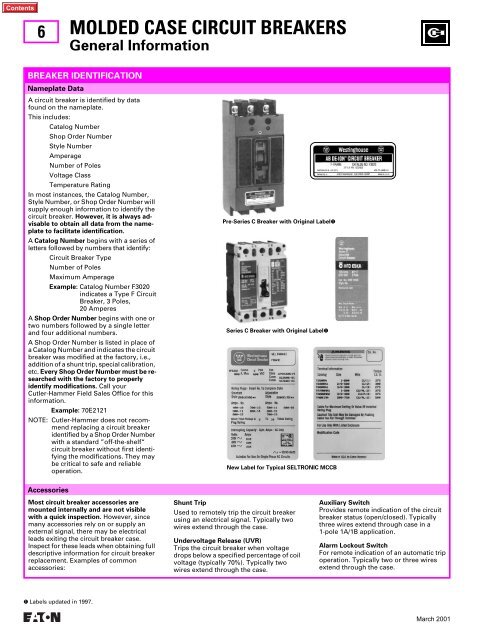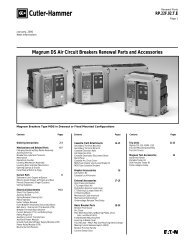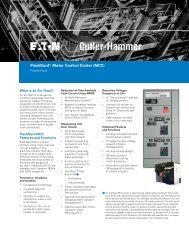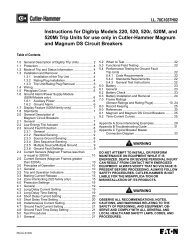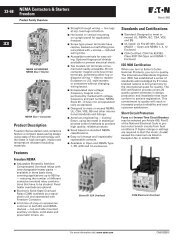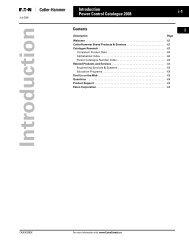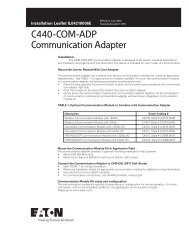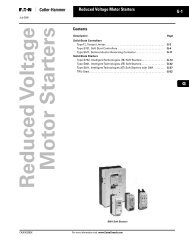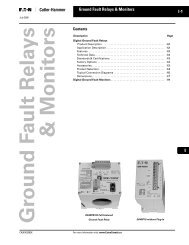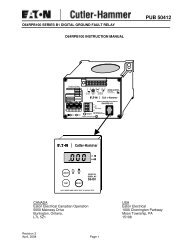molded case circuit breakers - Eaton Canada
molded case circuit breakers - Eaton Canada
molded case circuit breakers - Eaton Canada
You also want an ePaper? Increase the reach of your titles
YUMPU automatically turns print PDFs into web optimized ePapers that Google loves.
6<br />
Accessories<br />
MOLDED CASE CIRCUIT BREAKERS<br />
General Information<br />
BREAKER IDENTIFICATION<br />
Nameplate Data<br />
A <strong>circuit</strong> breaker is identified by data<br />
found on the nameplate.<br />
This includes:<br />
Catalog Number<br />
Shop Order Number<br />
Style Number<br />
Amperage<br />
Number of Poles<br />
Voltage Class<br />
Temperature Rating<br />
In most instances, the Catalog Number,<br />
Style Number, or Shop Order Number will<br />
supply enough information to identify the<br />
<strong>circuit</strong> breaker. However, it is always advisable<br />
to obtain all data from the nameplate<br />
to facilitate identification.<br />
A Catalog Number begins with a series of<br />
letters followed by numbers that identify:<br />
Circuit Breaker Type<br />
Number of Poles<br />
Maximum Amperage<br />
Example: Catalog Number F3020<br />
indicates a Type F Circuit<br />
Breaker, 3 Poles,<br />
20 Amperes<br />
A Shop Order Number begins with one or<br />
two numbers followed by a single letter<br />
and four additional numbers.<br />
A Shop Order Number is listed in place of<br />
a Catalog Number and indicates the <strong>circuit</strong><br />
breaker was modified at the factory, i.e.,<br />
addition of a shunt trip, special calibration,<br />
etc. Every Shop Order Number must be researched<br />
with the factory to properly<br />
identify modifications. Call your<br />
Cutler-Hammer Field Sales Office for this<br />
information.<br />
Example: 70E2121<br />
NOTE: Cutler-Hammer does not recommend<br />
replacing a <strong>circuit</strong> breaker<br />
identified by a Shop Order Number<br />
with a standard ”off-the-shelf“<br />
<strong>circuit</strong> breaker without first identifying<br />
the modifications. They may<br />
be critical to safe and reliable<br />
operation.<br />
Most <strong>circuit</strong> breaker accessories are<br />
mounted internally and are not visible<br />
with a quick inspection. However, since<br />
many accessories rely on or supply an<br />
external signal, there may be electrical<br />
leads exiting the <strong>circuit</strong> breaker <strong>case</strong>.<br />
Inspect for these leads when obtaining full<br />
descriptive information for <strong>circuit</strong> breaker<br />
replacement. Examples of common<br />
accessories:<br />
➊ Labels updated in 1997.<br />
Shunt Trip<br />
Pre-Series C Breaker with Original Label➊<br />
Series C Breaker with Original Label➊<br />
New Label for Typical SELTRONIC MCCB<br />
Used to remotely trip the <strong>circuit</strong> breaker<br />
using an electrical signal. Typically two<br />
wires extend through the <strong>case</strong>.<br />
Undervoltage Release (UVR)<br />
Trips the <strong>circuit</strong> breaker when voltage<br />
drops below a specified percentage of coil<br />
voltage (typically 70%). Typically two<br />
wires extend through the <strong>case</strong>.<br />
Auxiliary Switch<br />
Provides remote indication of the <strong>circuit</strong><br />
breaker status (open/closed). Typically<br />
three wires extend through <strong>case</strong> in a<br />
1-pole 1A/1B application.<br />
Alarm Lockout Switch<br />
For remote indication of an automatic trip<br />
operation. Typically two or three wires<br />
extend through the <strong>case</strong>.<br />
March 2001


